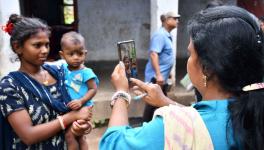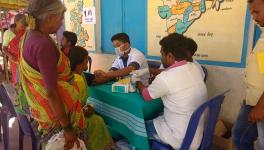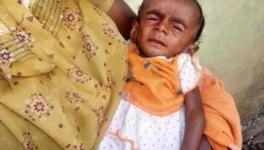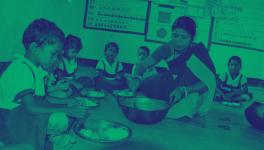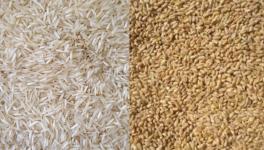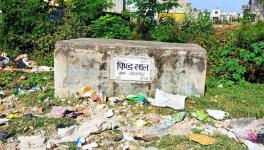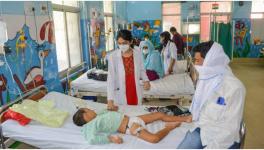Tragic Implications of Sinking Nutrition Budget
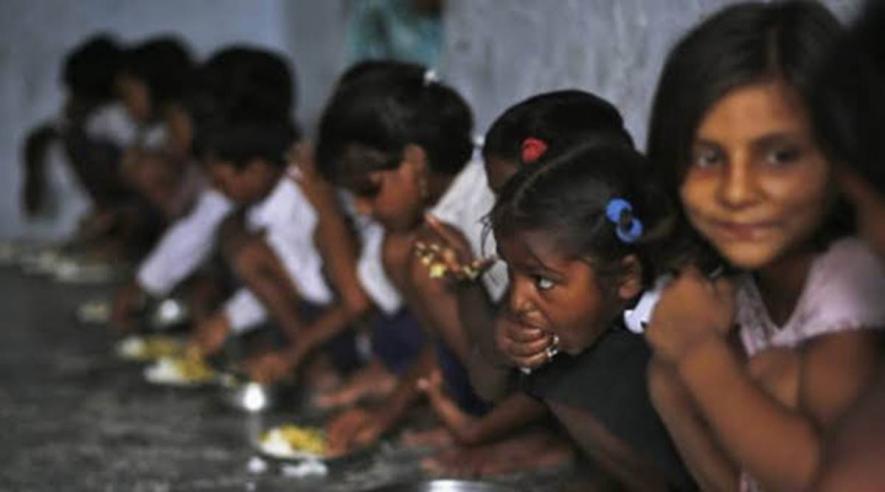
Image Courtesy: The Indian Express
The nutrition situation in India has consistently been a cause for serious concern. After a short phase of improvements in expenditure targeted to raise nutrition standards during the early-to-mid 2000s, the allocations have mostly stagnated. Now there is a fall in the nutrition standards in several parts of the country and it is directly linked to the falling expenditure on nutrition and healthcare.
Data from the 5th round of the National Family Health Survey, which focusses on the nutrition situation in 22 states and Union Territories, recently revealed that child stunting, wasting, and anemia, have zoomed upwards in many parts of the country. The Right to Food Campaign has pointed out that 35% of children under five are stunted, 33% are underweight, and 17% are wasted, a result of poor nutrition over a long period.
This is a reflection of the reversals in expenditure on basic needs of the working classes and the lowest rungs of the middle-classes. Particularly in the last roughly six years, this trend of under-spending and ignoring the health needs of the young, has caused the underperformance of nutrition programs.
The overall situation on the nutrition front is influenced by a complex set of factors, ranging from what services a state government provides as part of its nutrition mission, the allocations made by the Centre vis-a-vis the state, the existing healthcare and nutrition standards in a state, and the economic and social conditions of regions and families.
The combined impact of these and other factors is that the nutrition levels were falling even before the COVID-19 pandemic in India. The lockdown forced a shut-down of the schooling and Anganwadi system and hampered the delivery of essential services. (The impact this had on nutrition and child development will only be revealed in later health surveys, though evidence of hunger and deprivation already exists.)
India is home to one-sixth of the world population but it accounts for about one-third of the global burden of malnutrition. This is a serious national crisis and matter of worldwide concern too. The crisis of nutrition was aggravated by the pandemic and the accompanying lockdown—widely considered one of the most stringent in the world—which disrupted livelihoods and reduced the ability of millions of families to support the basic needs of their children.
Finally, court directives were issued to state governments to keep in mind the growing dependence on nutrition schemes and basic access to food during the lockdown, and to consider home-distribution of dry rations to beneficiaries. Wherever this directive was followed, the earlier shortages were reduced.
Keep in mind that there is an abundance of surplus food in India. The large food-stock means that it is possible to maintain and increase nutrition services too, especially after the most stringent phases of the lockdown were over. However, government support for several nutrition schemes has only decreased, with the program for free-of-cost supply of some cereals and pulses the only exception. This too was stopped in November despite the wide need for an extension.
Then came Union Budget, 2021-22. Keeping in view the pressing nutrition needs a big hike in allocations for nutrition schemes was expected but instead, there were cutbacks in some schemes. These cuts should be examined in combination with the cuts in expenditure over the last calendar year and the previous financial year.
In other words, the Revised Estimates (RE) of the financial year 2020-21 have to be compared to the original allocation or Budget Estimate (BE) of this financial year. Additionally, we must compare the BE of 2020-21 with the BE of the financial year 2021-22.
The BE for ICDS (Anganwadi centres) was Rs. 20,532 crore in 2020-21. The RE was Rs. 17,252 crore. Similarly, the allocation for POSHAN Abhiyan in the BE was Rs. 3,700 crore, which drastically reduced in the RE to Rs. 600 crore.
The scheme for adolescent girls, Sabla, had a BE of Rs. 250 crore, which was changed in the RE to Rs. 50 crore. The National Creche Scheme had a BE of Rs. 75 crore and the RE put it at Rs. 15 crore.
The latest budget has merged these four schemes to create a new “Saksham Anganwadi” or Mission Poshan 2.0, as recommended by the Fifteenth Finance Commission. Hence, now on, only the combined data for these four schemes is being provided. In the BE for 2021-22, the expenditure on these four schemes, combined into one, is 18.5% lesser than the combined BE of the four schemes in the previous year, 2020-21.
It is no longer possible to get the figures on the allocations for each of these four schemes separately, as only aggregated data is being provided. This will also make it difficult to monitor progress in these schemes. Nevertheless, the overall reduction of 18.5% is by any yardstick a big reduction and it has come at a time when a big hike was needed. So, what we have is a reduction at two levels: the fall in the BE compared to the RE last year and the reduction compared to the BE of both years.
The Inequality Report of Oxfam, released just before the budget, said the closure of government schools disrupted the Mid-Day Meals Scheme. This scheme covers 120 million [12 crore] children in 1.26 million [nearly 13 lakh] schools. Oxfam’s survey found that despite the Supreme Court saying this scheme must be continued, 35% children did not receive mid-day meals. Of the remaining 65%, eight per cent received cooked meals, 53% were given dry rations and four per cent got money in lieu of a meal. However, it is still not clear how the RE of this scheme has, according to the budget, increased to Rs. 12,900 crore compared to the BE of Rs. 11,000 crore. The BE for the next financial year is Rs. 11,500 crore.
Taking a longer-term perspective, the Right to Food Campaign has calculated (assuming an annual inflation rate of 5%), that in real terms the allocation for the mid-day meal scheme has declined by 38% from 2014-15 to the BE of 2021-22. On the basis of certain assumptions, this decline has been calculated at 36% for the Integrated Child Development Scheme (ICDS).
Now, the number of children and women to be covered by these schemes is steadily rising. Therefore, this decline in allocations is even more alarming. In 2015-16, only 48% of eligible children and 51% of pregnant women in rural areas (40% and 36% respectively in urban areas) were covered by the ICDS. Now, the extent of its reach is likely to have further reduced significantly. The Centre for Budget and Governance Accountability, in its review of the Union Budget 2021-22, has said that the total number of beneficiaries of the Supplementary Nutrition Program has fallen from 10.2 crores in 2016 to 8.6 crores in 2020, a 15% drop.
A review of POSHAN spending done some time back has revealed that a very high percentage of the expenditure was on purchasing mobile phones, which means even less was available for actual nutrition needs.
The RE of the National Food Security Mission was reduced to Rs. 1,864 crore from a BE of Rs. 2,100 crore in 2020-21. The RE for the White Revolution [milk production and consumption] in the same year was reduced to Rs. 1,642 crore from a BE of Rs. 1,805 crore. In the BE of 2021-22, this has been reduced sharply to Rs. 1,177 crore.
These declines in the allocations for nutrition, during a serious economic crisis that has already sparked widespread distress and hardship, is likely to have serious and tragic implications for the health and well-being of children and women.
The writer is a journalist and author. His recent books include Protecting Earth for Children and Planet in Peril. The views are personal.
Get the latest reports & analysis with people's perspective on Protests, movements & deep analytical videos, discussions of the current affairs in your Telegram app. Subscribe to NewsClick's Telegram channel & get Real-Time updates on stories, as they get published on our website.










